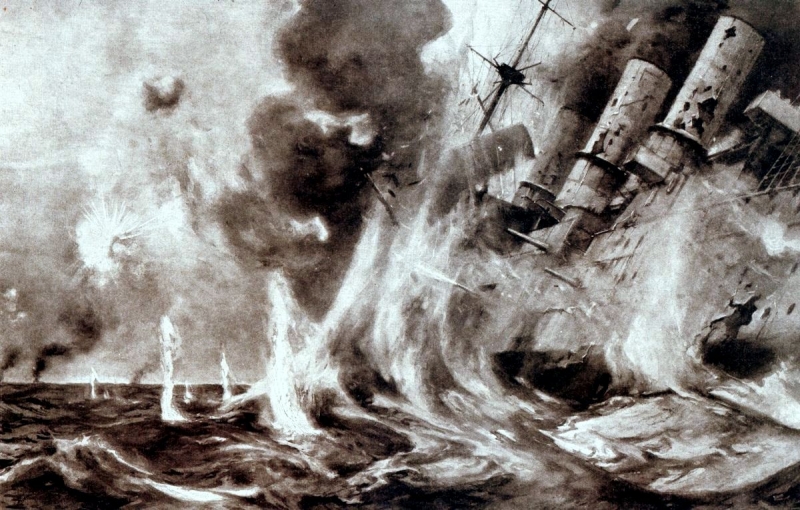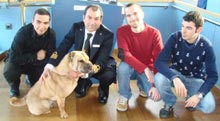| Previous Next |
 |
| Sinking of SMS SCHARNHORST |
| Career (German Empire) Name: Scharnhorst Namesake: Gerhard von Scharnhorst Laid down: 22 March 1905 Launched: 23 March 1906 Commissioned: 24 October 1907 Fate: Sunk in action, Battle of the Falkland Islands, 8 December 1914 General characteristics Class and type: Scharnhorst-class armored cruiser Displacement: 12,985 t (12,780 long tons) Length: 144.6 m (474 ft 5 in) Beam: 21.6 m (70 ft 10 in) Draft: 8.37 m (27 ft 6 in) Installed power: ? 18 water-tube boilers ? 26,000 indicated horsepower (19,000 kW) Propulsion: 3 shafts 3 ? triple-expansion steam engines Speed: 22.5 knots (41.7 km/h; 25.9 mph) Crew: 52 officers 788 enlisted Armament: ? 8 ? 21 cm (8.3 in) guns ? 6 ? 15 cm (5.9 in) guns ? 18 ? 8.8 cm (3.5 in) guns ? 4 ? 45 cm (17.7 in) torpedo tubes Armor: ? Belt: 15 cm ? Turrets: 18 cm (7.1 in) ? Deck: 3.5 to 6 cm (1.4 to 2.4 in) Seiner Majest?t Schiff His Majesty's Ship. Battle of the Falkland Islands Once word of the defeat reached London, the Royal Navy set to organizing a force to hunt down and destroy the East Asia Squadron. To this end, the powerful new battlecruisers Invincible and Inflexible were detached from the Grand Fleet and placed under the command of Vice Admiral Doveton Sturdee.[43] The two ships left Devonport on 10 November and while en route to the Falkland Islands, they were joined by the armored cruisers Carnarvon, Kent, and Cornwall, the light cruisers Bristol and Glasgow, and Otranto. The force of eight ships reached the Falklands by 7 December, where they immediately coaled. In the meantime, Spee's ships departed St. Quentin Bay on 26 November and rounded Cape Horn on 2 December. They captured the Canadian barque Drummuir, which had a cargo of 2,500 t (2,500 long tons; 2,800 short tons) of good-quality Cardiff coal. Leipzig took the ship under tow and the following day the ships stopped off Picton Island. The crews transferred the coal from Drummuir to the squadron's colliers. On the morning of 6 December, Spee held a conference with the ship commanders aboard Scharnhorst to determine their next course of action. The Germans had received numerous fragmentary and contradictory reports of British reinforcements in the region; Spee and two other captains favored an attack on the Falklands, while three other commanders argued that it would be better to bypass the islands and attack British shipping off Argentina. Spee's opinion carried the day and the squadron departed for the Falklands at 12:00 on 6 December. Gneisenau and N?rnberg were delegated for the attack; they approached the Falklands the following morning, with the intention of destroying the wireless transmitter there. Observers aboard Gneisenau spotted smoke rising from Port Stanley, but assumed it was the British burning their coal stocks to prevent the Germans from seizing them. As they closed on the harbor, 30.5 cm (12.0 in) shells from Canopus, which had been beached as a guard ship, began to fall around the German ships, which prompted Spee to break off the attack. The Germans took a south-easterly course at 22 kn (41 km/h; 25 mph) after having reformed by 10:45. Scharnhorst was the center ship, with Gneisenau and N?rnberg ahead and Dresden and Leipzig astern. The fast battlecruisers quickly got up steam and sailed out of the harbor to pursue the slower East Asia Squadron. By 13:20, the British ships had caught up with Scharnhorst and the other cruisers and began firing at a range of 14 km (8.7 mi). Spee realized his armored cruisers could not escape the much faster battlecruisers and ordered the three light cruisers to attempt to break away while he turned about and allowed the British battlecruisers to engage the outgunned Scharnhorst and Gneisenau. Meanwhile, Sturdee detached his cruisers to pursue the German light cruisers. Invincible opened fire at Scharnhorst while Inflexible attacked Gneisenau and Spee ordered his two armored cruisers to similarly engage their opposites. Spee had taken the lee position; the wind kept his ships swept of smoke, which improved visibility for his gunners. This forced Sturdee into the windward position and its corresponding worse visibility. Scharnhorst straddled Invincible with her third salvo and quickly scored two hits on the British battlecruiser. The German flagship was herself not hit during this phase of the battle. Sturdee attempted to widen the distance by turning two points to the north to prevent Spee from closing to within the range of his numerous secondary guns. Spee counteracted this maneuver by turning rapidly to the south, which forced Sturdee to turn south as well to keep within range. This allowed Scharnhorst and Gneisenau to turn back north and get close enough to engage with their secondary 15 cm guns. Their shooting was so accurate that it forced the British to haul away a second time. After resuming the battle, the British gunfire became more accurate; Scharnhorst was hit several times and fires broke out. The pace of her gunfire started to slacken, though she continued to score hits on Invincible. Sturdee then turned to port in an attempt to take the leeward position, but Spee countered the turn to retain his favorable position; the maneuvering did, however, reverse the order of the ships, so Scharnhorst now engaged Inflexible. By this stage of the battle, Scharnhorst had a slight list to port and was about a meter lower in the water. Her third funnel had been shot away. Gneisenau was briefly obscured by smoke, which led both battlecruisers to target Scharnhorst. By 16:00, Spee ordered Gneisenau to attempt to escape while he reversed course and attempted to launch torpedoes at his pursuers. The port list had increased significantly by this point and she was well down by the bow, with only 2 meters (6 ft 7 in) of freeboard. At 16:17, the ship finally capsized to port and sank; the British, their attention now focused on Gneisenau, made no attempt to rescue the crew. All 860 officers and men on board, including Spee, went down with the ship. Gneisenau, Leipzig, and N?rnberg were also sunk. Only Dresden managed to escape, but she was eventually tracked to the Juan Fernandez Islands and sunk. The complete destruction of the squadron killed about 2,200 German sailors and officers, including two of Spee's sons. In mid-1915, a coastal steamer found the body of a German sailor off the coast of Brazil. The sailor had a watertight cartridge case from a 21 cm shell attached; inside was one of the Reichskriegsflaggen (Imperial war flags) flown aboard Scharnhorst. The sailor was buried in Brazil and the flag was eventually returned to Germany, where it was placed on display at the Museum f?r Meereskunde (Marine Science) in Berlin, though it was lost during World War II. In the mid-1930s, the new German navy, the Kriegsmarine, built a battleship named for Scharnhorst. At the launching of the new Scharnhorst in October 1936, the widow of the earlier ship's captain was present. |
| Username | |
| Shipowner | German Imperial Fleet. |
| Ship manager | |
| IMO Number | |
| Type of ship | Panzer Kreuzer |
| Year of build and builder | 1907 |
| Date | |
| Place | |
| Added on | 09/05/2015 |
| Dimension | 1200 x 764 |
| viewed | 2058 |
















